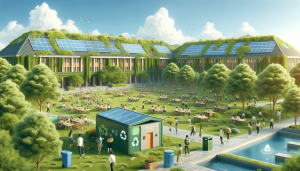In our journey to protect the planet, we often wonder how we can personally contribute to raising awareness about pressing environmental issues. This article explores practical and impactful strategies we can adopt to advocate for a healthier and more sustainable world. From using social media to spread important messages, to organizing community events, and even making changes in our daily lives, we’ll discover a variety of ways to inspire others and amplify the call for environmental action. Together, we can make a significant difference in preserving the Earth for future generations. How can we raise awareness about environmental issues?
That’s a question many of us have asked ourselves at some point. As we see the world around us changing due to environmental issues like climate change, deforestation, and pollution, it becomes increasingly clear that we need to act now. But how? Turning our collective concern into meaningful action begins with raising awareness, which can empower individuals and communities to make a difference.
Understanding Environmental Issues
What Are Environmental Issues?
First, let’s define what we mean by “environmental issues.” These are problems that arise from human activity and natural processes that negatively impact the Earth’s ecosystems and thereby human health. Examples include climate change, biodiversity loss, deforestation, pollution, and energy depletion.
Why Is Awareness Important?
Raising awareness is crucial because it serves as the first step toward taking actionable measures. When people are informed about an issue, they are more likely to care about it and take steps to mitigate the problem. Awareness can lead to changes in behavior, policy, and society as a whole.
Methods to Raise Awareness
Harnessing Social Media
In today’s digital age, social media is one of the most effective tools we have for raising awareness. Platforms like Facebook, Twitter, Instagram, and TikTok allow us to reach a broad audience quickly and easily.
Tips for Using Social Media:
- Share Informative Content: Post articles, infographics, and videos that explain environmental issues clearly.
- Engage Your Audience: Pose questions, create polls, and encourage discussions to foster a community of concerned individuals.
- Collaborate With Influencers: Partnering with influencers who care about the environment can amplify your message.
Organizing Community Events
Organizing events in our community is a powerful way to get people involved. Community events can range from clean-up drives and tree planting activities to educational workshops and seminars.
Types of Community Events:
| Event Type | Description |
|---|---|
| Clean-up Drives | Gather volunteers to clean up local parks, beaches, or neighborhoods. |
| Tree Planting | Organize a day where community members come together to plant trees. |
| Workshops | Offer educational sessions on topics like recycling, composting, or sustainable living. |
| Seminars | Invite experts to speak on pressing environmental issues. |
Educational Programs
Education plays a critical role in raising awareness. Schools, colleges, and community centers are ideal places to implement educational programs focused on environmental issues.
How to Implement Educational Programs:
- Curriculum Integration: Encourage schools to integrate environmental education into their curriculum.
- Guest Lectures: Invite experts to discuss various environmental topics.
- Field Trips: Organize trips to natural reserves, recycling facilities, or sustainable farms to give people firsthand experience.
Utilizing Traditional Media
While social media is essential, we shouldn’t overlook traditional media outlets like newspapers, radio, and television. These platforms can reach demographics that might not be as active online.
Effective Ways to Use Traditional Media:
- Write Articles: Contribute op-eds and articles to local newspapers.
- Public Service Announcements: Create radio and TV ads that highlight environmental issues.
- Interviews: Appear on local news shows to discuss ongoing environmental concerns and solutions.

Why Individual Actions Matter
The Ripple Effect
Individual actions may seem insignificant at first glance, but they can create a ripple effect. When one person makes a change, it often inspires others to follow suit. Simple actions such as reducing waste, conserving water, and using public transport can accumulate to make a significant impact.
Leading by Example
People are more likely to adopt environmentally friendly practices if they see others doing the same. By making sustainable choices ourselves, we set an example for others to follow. This form of ‘leading by example’ can be very effective in spreading awareness.
Collaborating with Organizations
Partnering with NGOs
Non-Governmental Organizations (NGOs) focusing on environmental protection can be valuable allies in raising awareness. These organizations often have the expertise, resources, and networks needed to effect change.
Benefits of Collaborating with NGOs:
- Resource Sharing: NGOs can provide educational materials, training, and other resources.
- Broader Reach: Leverage the NGO’s platform and network to reach a wider audience.
- Credibility: Partnership with an established NGO can lend credibility to your efforts.
Corporate Social Responsibility (CSR)
Businesses have a significant role to play in environmental sustainability. By partnering with companies on CSR initiatives, we can utilize their resources and reach to promote environmental awareness.
Examples of CSR Initiatives:
- Green Campaigns: Collaborate on campaigns that promote recycling, reduce plastic use, or encourage renewable energy.
- Sustainable Products: Work with companies to develop and promote eco-friendly products.
- Workshops and Training: Offer training programs for employees on sustainability practices.

Legislative Advocacy
Lobbying for Change
Advocacy isn’t just about grassroots efforts; it also involves pushing for systemic change through legislation. By lobbying for stronger environmental laws and policies, we can create long-term impacts.
Steps to Effective Lobbying:
- Research: Understand the legislative process and the issues at hand.
- Build a Coalition: Join forces with like-minded individuals and organizations.
- Engage Lawmakers: Meet with legislators to discuss your concerns and solutions.
Public Campaigns
Public campaigns aimed at influencing policy can be highly effective in raising awareness and applying pressure on policymakers. Campaigns can include petitions, letter-writing efforts, and public demonstrations.
Measuring Impact
Key Performance Indicators (KPIs)
It’s crucial to measure the impact of our awareness-raising efforts. This not only helps to understand what works and what doesn’t but also keeps us motivated by showcasing tangible results.
KPIs to Consider:
| KPI | Description |
|---|---|
| Social Media Engagement | Measure likes, shares, comments, and overall reach. |
| Event Participation | Track the number of attendees and volunteers in community events. |
| Educational Program Outcomes | Assess the knowledge gained by participants through quizzes or surveys. |
| Media Coverage | Monitor the number of articles published, interviews conducted, and PSAs aired. |
Feedback Loops
Create mechanisms to gather feedback from participants in your awareness programs. Feedback can provide valuable insights into what’s working and areas that might need improvement.
Methods for Gathering Feedback:
- Surveys: Distribute surveys to event participants and social media followers.
- Focus Groups: Conduct focus group discussions to gain in-depth insights.
- Online Reviews: Monitor online reviews and comments to gauge public opinion.
Sustaining Efforts
Building a Community
One of the most effective ways to ensure that our awareness-raising efforts are sustained is by building a strong, engaged community. Communities can provide support, share resources, and help maintain momentum.
How to Build a Community:
- Online Platforms: Create Facebook groups, LinkedIn communities, or forums where people can share ideas and collaborate.
- Regular Meetups: Organize regular meetups and events to keep people engaged.
- Newsletters: Send out regular newsletters to update community members on progress, upcoming events, and ways to get involved.
Leveraging Technology
Technology can be a great ally in our quest to raise awareness about environmental issues. From mobile apps that help people track their carbon footprints to platforms that enable virtual events, leveraging technology can amplify our efforts.
Useful Technological Tools:
- Environmental Apps: Apps like iRecycle can help people find recycling centers, while Oroeco tracks personal carbon footprints.
- Online Platforms: Use platforms like Zoom for virtual workshops and webinars.
- Data Analytics: Employ data analytics to measure the effectiveness of your campaigns and make informed decisions.
Conclusion
Raising awareness about environmental issues is a multi-faceted endeavor that requires the collective effort of individuals, communities, organizations, and governments. By leveraging tools such as social media, traditional media, community events, educational programs, and legislative advocacy, we can create a significant impact. The power to change the world lies in our hands, and it starts with awareness. By taking informed actions and inspiring others to do the same, we can make a substantial difference in the fight against environmental degradation. Let’s work together to create a sustainable future for ourselves and generations to come.



